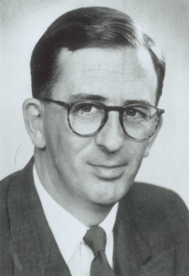



Provenance
1 - Sloman, Arthur Raymond
1 - Sloman, Arthur Raymond
|
Home Provenance Series List Search |
| Date Range | 1915 - 1997 |
| Details The following information was provided by Ray Sloman's son Bill. Ray Sloman worked in Burnie, Tasmania, for Associated Pulp and Paper Mills (APPM) from 1939 to 1965. In that time Associated Pulp and Paper Mills developed and patented two innovations in chemical wood pulping - the "two stage cook" and the "continuous counter-current cook" - and Ray Sloman was named as the inventor on both patents. Continuous counter-current cooking became the standard technique for chemical wood pulping. When Ray joined APPM in 1939, the company made paper pulp using a batch process, loading woods chips, sodium hydroxide and water into an over-sized pressure cooker, cooking for six hours at about 150°C. The wood consists of cellulose fibres bound together by "lignin", and the sodium hydroxide (caustic soda) solution dissolved the lignin, leaving the chips with the consistency of wet blotting paper, to be broken up into pulp in the beaters. He did a lot of tedious work on the kinetics of this process in the 1940s, cooking small pressure vessels at precisely controlled temperature for specific periods - such as one, two three and four hours - then stopping the reaction and analysing the contents of the vessel. On the basis of this work, he proposed the "two stage cook", in which the wood chips were first cooked for a few hours in the spent liquor from the previous batch, to extract the more easily shifted components of the lignin, then the spent liquor was drained off and replaced by virgin caustic soda to complete the extraction. This allowed the extraction to be carried out faster, with less caustic soda per ton of oven-dry wood, and became the standard pulping process at the Burnie mill. The company patented the process internationally in the early 1950s. When the Burnie mill bought its first continuous digester (the sixth in the world and the second in the southern hemisphere) it was fitted with extra pipe-work to allow it to run a continuous variant of the two stage cook. This was successful and their second continuous digester was further modified to allow counter-current washing of the cooked chips in the bottom of the digester. Once this unit was installed and running, Ray proposed running the whole digester counter current, injecting virgin caustic soda at the base of the digester, just above the washing zone, while the chips were to be loaded at the top in the usual way and sink through the rising column of cooking liquor. This could be tested relatively cheaply - for about $100,000 - on the existing digester, albeit at the risk of disrupting production. The trials were carried out around 1960, and were successful. The process was patented in Australian and overseas, and was in routine use at the Burnie mill by the end of 1961, when it was shown to Kamyr - the Norwegian firm that built the digesters. Kamyr never took a license to supply their digesters configured for counter-current cooking and were officially skeptical about the process until the patents expired. Some pulp mills were interested in licensing the process, and in 1965, in order to free up Ray to handle these enquiries, he moved from his position as Research Manager at the Burnie site to become a partner in a Melbourne consulting engineering business - Burghart, Sloman and Associates - in which APPM was the third partner. He remained an employee of APPM. The enquiry that inspired APPM to set up this situation came to nothing when the two Canadians central to the proposal died in a car accident, and there were no further significant enquiries. Despite this the partnership was successful and profitable until Burghart retired for health reasons in 1971, when APPM chose to close it down. Ray was given a desk, but no work, in APPM's Melbourne office, and resigned from APPM on 17 September, with effect from 30 October, to move to the Austin Company Limited, Engineers and Builders, on 1 November as a pulp and paper consultant for their Australian office. He remained active in the pulp and paper industry as an consultant until his retirement in 1982 but took no further part in research and innovation after 1971. | |
|
Published by the the University of Melbourne eScholarship Research Centre on AustechWeb, September 2009
ISBN 978-0-7340-4118-0 Listed by Barbara Cytowicz, Catherine Hall and Michael Jones HTML edition Updated 6 April 2011 http://www.austehc.unimelb.edu.au/guide/slom/SLP0001.htm The template for this finding aid is part of the Heritage Documentation Management System |
[ Top of Page | Home | Series | Provenance | Search ] |